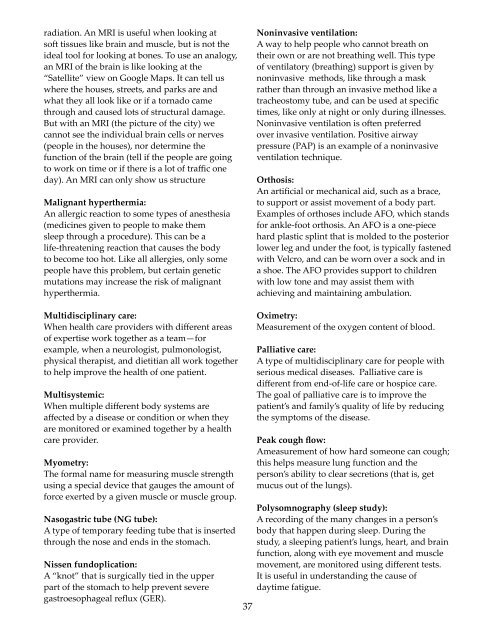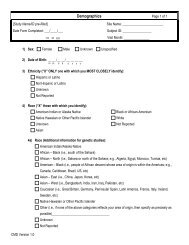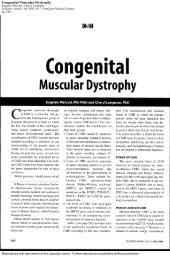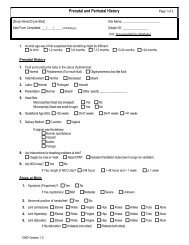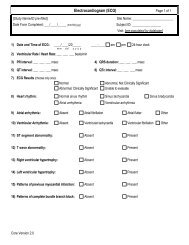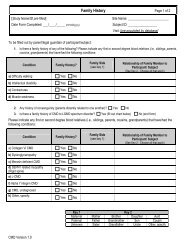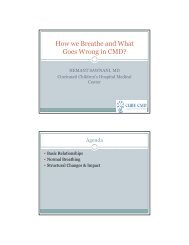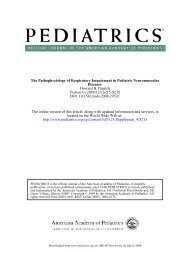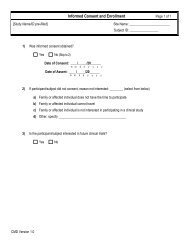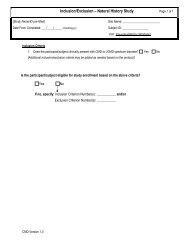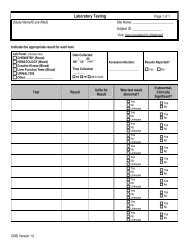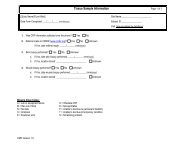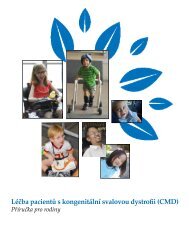The Management of Congenital Muscular Dystrophy ... - Cure CMD
The Management of Congenital Muscular Dystrophy ... - Cure CMD
The Management of Congenital Muscular Dystrophy ... - Cure CMD
You also want an ePaper? Increase the reach of your titles
YUMPU automatically turns print PDFs into web optimized ePapers that Google loves.
adiation. An MRI is useful when looking ats<strong>of</strong>t tissues like brain and muscle, but is not theideal tool for looking at bones. To use an analogy,an MRI <strong>of</strong> the brain is like looking at the“Satellite” view on Google Maps. It can tell uswhere the houses, streets, and parks are andwhat they all look like or if a tornado camethrough and caused lots <strong>of</strong> structural damage.But with an MRI (the picture <strong>of</strong> the city) wecannot see the individual brain cells or nerves(people in the houses), nor determine thefunction <strong>of</strong> the brain (tell if the people are goingto work on time or if there is a lot <strong>of</strong> traffic oneday). An MRI can only show us structureMalignant hyperthermia:An allergic reaction to some types <strong>of</strong> anesthesia(medicines given to people to make themsleep through a procedure). This can be alife-threatening reaction that causes the bodyto become too hot. Like all allergies, only somepeople have this problem, but certain geneticmutations may increase the risk <strong>of</strong> malignanthyperthermia.Noninvasive ventilation:A way to help people who cannot breath ontheir own or are not breathing well. This type<strong>of</strong> ventilatory (breathing) support is given bynoninvasive methods, like through a maskrather than through an invasive method like atracheostomy tube, and can be used at specifictimes, like only at night or only during illnesses.Noninvasive ventilation is <strong>of</strong>ten preferredover invasive ventilation. Positive airwaypressure (PAP) is an example <strong>of</strong> a noninvasiveventilation technique.Orthosis:An artificial or mechanical aid, such as a brace,to support or assist movement <strong>of</strong> a body part.Examples <strong>of</strong> orthoses include AFO, which standsfor ankle-foot orthosis. An AFO is a one-piecehard plastic splint that is molded to the posteriorlower leg and under the foot, is typically fastenedwith Velcro, and can be worn over a sock and ina shoe. <strong>The</strong> AFO provides support to childrenwith low tone and may assist them withachieving and maintaining ambulation.Multidisciplinary care:When health care providers with different areas<strong>of</strong> expertise work together as a team—forexample, when a neurologist, pulmonologist,physical therapist, and dietitian all work togetherto help improve the health <strong>of</strong> one patient.Multisystemic:When multiple different body systems areaffected by a disease or condition or when theyare monitored or examined together by a healthcare provider.Myometry:<strong>The</strong> formal name for measuring muscle strengthusing a special device that gauges the amount <strong>of</strong>force exerted by a given muscle or muscle group.Nasogastric tube (NG tube):A type <strong>of</strong> temporary feeding tube that is insertedthrough the nose and ends in the stomach.Nissen fundoplication:A “knot” that is surgically tied in the upperpart <strong>of</strong> the stomach to help prevent severegastroesophageal reflux (GER).37Oximetry:Measurement <strong>of</strong> the oxygen content <strong>of</strong> blood.Palliative care:A type <strong>of</strong> multidisciplinary care for people withserious medical diseases. Palliative care isdifferent from end-<strong>of</strong>-life care or hospice care.<strong>The</strong> goal <strong>of</strong> palliative care is to improve thepatient’s and family’s quality <strong>of</strong> life by reducingthe symptoms <strong>of</strong> the disease.Peak cough flow:Ameasurement <strong>of</strong> how hard someone can cough;this helps measure lung function and theperson’s ability to clear secretions (that is, getmucus out <strong>of</strong> the lungs).Polysomnography (sleep study):A recording <strong>of</strong> the many changes in a person’sbody that happen during sleep. During thestudy, a sleeping patient’s lungs, heart, and brainfunction, along with eye movement and musclemovement, are monitored using different tests.It is useful in understanding the cause <strong>of</strong>daytime fatigue.


